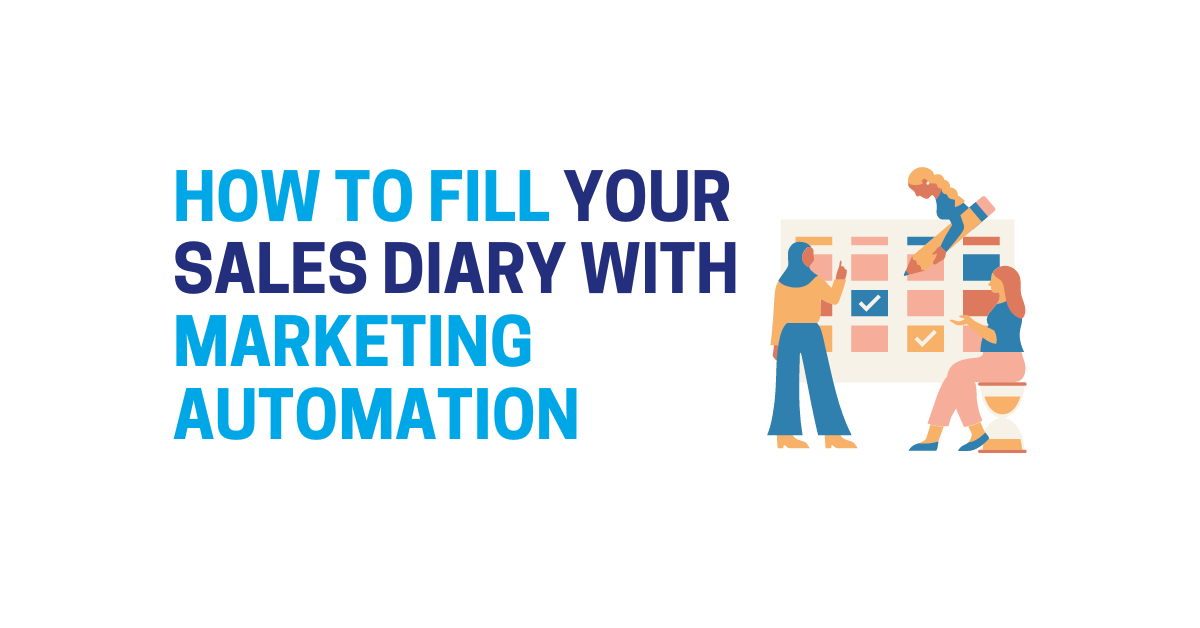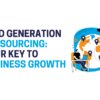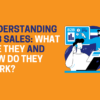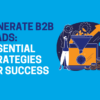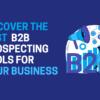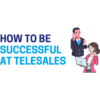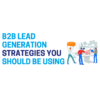Mastering How to Fill Your Sales Diary with Marketing Automation
Imagine if your sales diary was always overflowing with people wanting to buy your products and services. That would be great, wouldn’t it?
Unfortunately, getting to that enviable position takes a lot of work. But what if you could automate the process?
Amazingly, the technology to make that happen already exists. It’s called marketing automation software and can be an excellent way for B2B telesales companies to fill their pipelines and generate more revenue.
Understanding Marketing Automation
But first, what is marketing automation?
Marketing automation is essentially what it sounds like – software tools that do various outreach tasks for you. For example, you can get tools to:
- Send out promotional emails to prospects on your email list
- Post social media content
- Segment customers into various groups by demographics, psychographics or other dividing lines
- Score leads (telling you what they are likely worth to your brand)
- Send little nudges or messages to prospects to push them toward conversion
Enhanced marketing automation is becoming possible because of advances in technology. AI is getting better at figuring out how to automate specific processes, making it useful in more applications.
Furthermore, vendors can now see its value and are investing heavily. They know companies like yours are desperate for solutions that reduce the task burden on their sales and marketing teams.
Filling the Sales Funnel with Marketing Automation
Vendor marketing automation software advances every year and is often more capable than most B2B telemarketers realise. As such, there are numerous ways to use it to fill your sales diary.
Real-Time Alerts
Marketing automation sometimes takes the form of real-time alerts. These notify your team whenever a prospect activates a specific trigger (usually defined by you), such as downloading an ebook or filling out a form. Then, salespeople can call them back or schedule a follow-up call with them.
Real-time alerts are helpful because they increase the likelihood of conversion. You can see when prospects are most interested in your services and when you should reach out.
Drip Campaigns
Marketing automation is also helpful for your drip campaigns. You can set up tools to send clients emails at intervals to keep the relationship strong after the initial touchpoint. These prime them for future, in-person or over-the-phone interactions by teaching them about your products and services, and what you offer.
Most drip campaigns contain five to ten emails, sent over one to ten weeks. These provide helpful information, such as:
- The benefits of your product or services
- The common objections customers have before buying from brands like yours
- How leads can use your products or services better
Try to sequence your drip campaigns in the most logical order possible. Start with introductory content and then build leads’ knowledge over time. Overcoming objections encourages leads to take your proposals seriously.
Lead Generation
Lead generation is another application of marketing automation that fills your sales funnels. The software often has advanced features to find new prospects, like adding leads to your CRM and categorising them based on predefined criteria.
Tools funnel leads from various sources including:
- Gated content
- Landing pages
- Forms
- Social media
These ensure a steady flow of clients and reduce the work involved in filling your sales pipeline. Salespeople can just look at who is on the books and whether they should contact them.
Cross-Selling And Upselling
Marketing automation is also helpful for cross-selling and upselling. It can provide data insights from prospects’ purchasing behaviour that increase the likelihood and value of sales.
For example, marketing automation can suggest alternative products prospects might prefer to their existing choice. These could be more suitable for their requirements and generate better reviews.
Automation tools can also recommend superior products to leads looking for more features or a better experience. Going after existing customers like this can increase value further without requiring fresh outreach.
Ongoing Engagement With Past Leads
Lastly, marketing automation is helpful when you want to maintain continuous engagement with past leads. Software tools make it straightforward to stay in touch with customers who might come back to you in the future.
This form of marketing automation is particularly essential for businesses that only sell to customers occasionally (i.e. once or twice a year). It builds brand loyalty and reminds clients to use you when they next need products and services like yours (preventing them from drifting off or going to a rival).
Setting up Sales Automation for SMBs
Setting up a sales automation is quite straightforward for SMBs. However, it does require some planning.
Step 1: Think About The Sales Processes You Want To Automate
The first stage is to consider the processes you want to automate.
The best way to do this is to map your existing, non-automated funnels so you can understand how they evolve from initial B2B telesales to final conversion.
Repetitive tasks are the most amenable to automation, so look for these in your pipeline and write them down in a list. We’ve already discussed some of these, like sending drip emails and entering data into your CRM via integrations, but there are many more. (What about your social media posts?)
Advances in AI are also making more creative and complex tasks automatable. Therefore, look for these in your sales pipeline, too, asking whether artificial intelligence tools could do the work for you.
Step 2: Choose Suitable Automation Tools For Your Tasks
The next step is to search for tools that automate the tasks on your shortlist. (Don’t worry, you don’t have to automate them all).
The easiest place to start is with email automation software. Packages like ActiveCampaign and MailChimp make it straightforward to set up drip campaigns while reaching a mass audience. These keep firing off emails to prospects at various intervals, keeping them “on the boil” and interested in what you sell.
Next, you could move to business appointment-setting tools. Apps like Acuity Scheduling and Calendly automate scheduling, reducing secretarial requirements. You simply tell the app when you’re available and get clients to arrange appointments online.
Lead scoring tools are more complex. These define the value of leads so you know who to chase for sales.
Most lead-scoring tools plug into CRMs (or come natively). However, you can also get separate add-ons for more features and functionality. HubSpot, Zoho CRM, and Pipedrive all make customer relationship software your SMBs should consider.
Step 3: Set Up Lead Capture Automation
After that, look for tools and platforms that can automate lead funnelling. Most brands start by integrating social media into their CRMs, particularly LinkedIn and Facebook, as it tends to be straightforward to set up. These solutions often have facilities that link to your business accounts, allowing them to plug into prospects rapidly.
Once that’s done, it’s time to set up other facilities to capture leads (without cold calling or B2B telemarketing). Ideas include:
- Putting forms on your landing pages (preferably offering goodies in exchange for signing up!)
- Creating landing pages that use a combination of text and video to encourage sales
- Adding chatbots to web pages that can provide guidance and answer user questions
Again, you can occasionally connect these funnels to your CRM, providing salespeople with a single point of truth. Data feeds into the dashboard for quick analysis and integration with other customer relationship management features.
Step 4: Leverage Lead Nurturing
At the same time, you can also leverage automation for lead nurturing.
For example, some companies make initial contact with a prospect and then use follow-up automation to send them emails and reminders about their products and services. These are similar to the drip campaigns discussed above.
You can also use some CRMs to send prospects personalised messaging, designed to get them to convert. Again, these texts can reference their company, name, or interests, whether for B2B outbound telemarketing or not.
These approaches are useful in industries with long buying cycles. You can maintain your outreach efforts over long periods without dedicating time to them.
Step 5: Set Up Reporting
Once you have a simple framework for automating tasks, the next step is to set up reporting. Adding analytics to your processes helps you identify what works (and what doesn’t).
The simplest place to start is with your CRM’s sales dashboard. It provides real-time data on your marketing campaign performance, letting you adjust it whenever needed.
You can also set up team and individual performance tracking. These analytics let you see whether your salespeople are marketing effectively or require further training/reassignment.
Custom reports may be helpful in some businesses, particularly those reliant on a high volume of sales to survive. These can contain detailed information on sales funnel performance daily, weekly, monthly, or quarterly.
Step 6: Integration With Other Systems
Finally, the cleverest sales funnel setups always integrate automation with other systems.
For example, many businesses link their sales automation tools with their broader marketing platforms. These feed data directly into where it’s being used, enabling more comprehensive analysis.
Automation software can even link with accounting solutions. For example, some businesses link CRMs with apps like Xero and QuickBooks to reduce end-of-year paperwork. Zendesk and other customer support apps can benefit from knowing when a customer made a purchase and their experience afterwards. Feeding sales funnel information into these tools can assist customer service agents by providing them with information on the client value when they made their purchase, and whether they chose a basic or premium option.
Maximising Sales: The Benefits of Automated Funnels
The benefits of automated sales funnels are enormous for brands that use them. Companies can look forward to all sorts of perks – some of which we discuss below.
Better Lead Nurturing
The primary benefit of sales automation is improved lead nurturing. The technology makes it more straightforward for your brand to stay in touch with prospects likely to buy from you without dedicating any labour to the task.
Greater Efficiency
Greater efficiency is another advantage of sales automation. Salespeople no longer need to carry out as many repetitive, low-value tasks because the software does it for them.
Furthermore, these tools reduce manual effort significantly, improving working conditions and staff engagement levels.
Personalised Engagement
Personalised engagement is also a reason to choose to build automated funnels. Tools let you customise how you interact with leads based on their behaviour and characteristics, keeping them more engaged than conventional, generic, and dry emails.
Other Benefits:
- Increased conversion rates – Automated tools can send marketing messages to prospective customers focusing on the value propositions they care about the most. Some tools can also send communications when users activate specific behavioural triggers that suggest they may be more likely to convert.
- Improved lead scoring – Automated tools make it more straightforward to determine the importance of specific prospects, helping sales teams focus on those with the highest lifetime value.
- Better prospect segmentation – Automated sales funnels can segment buyers by criteria based on previous interactions or company size in the case of B2B, improving marketing targeting.
- Enhanced customer journey – Automated funnels make clients feel like they are progressing through the sales pipeline naturally.
- Greater insights – Automation tools provide detailed data-driven and evidence-based insights into each stage of the sales process for more forensic analyses
- Reduce labour costs – Automation tools eliminate repetitive tasks and enable staff to focus on more creative pursuits
The Future of Sales: Automation in Funnel Management
According to McKinsey & Co. around a third of sales operations tasks are now automatable with existing solutions. Therefore, companies will spend most of the future learning how to use new software and apps to automate their processes and experience the benefits described above at scale.
Interestingly, opportunities exist all along the sales value chain. For example, tools can help with:
- Sales strategy – Monitoring pipeline health (are enough new leads coming through?), gathering marketing intelligence, and profiling customers to reduce churn.
- Identifying leads – Automating marketing workflows, evaluating and prioritising leads, and using chatbots to collect preliminary information
- Managing orders – Tracking SLAs, and introducing smart customer billing and inventory workflows
- Conducting post-sales follow-up – Cross-selling, upselling, activating products and optimising the client’s journey
Wrapping Up
In summary, filling your sales diary with marketing automation is now possible, thanks to advanced and capable tools. While telemarketing for B2B remains relevant, sales automation can enhance processes and reduce workload.

Ryan Whyte is a Director of The Lead Generation Company where he leads a team of B2B telemarketers to deliver high-quality leads for clients. With a strong background in campaign management and a focus on driving results, Ryan is dedicated to optimising strategies that maximise client success in B2B lead generation.






